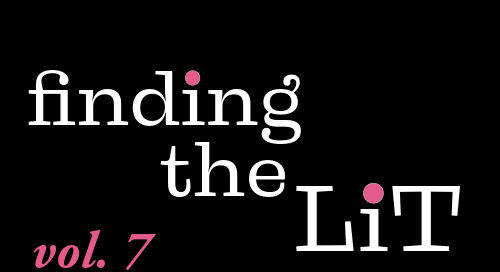Welcome to a very special edition of finding the lit!
In this one, I’ll review1 two lit-fic2 novels (whole-ass novels!) I read that were posted serially right here on Substack.3
Not too long ago I posted this tongue-in-cheek Note about the nature of fiction on Substack:
Of course, I didn’t really message Michael Chabon.
But I am fortunate to feel comfortable enough to reach out to the two authors of these serials—
and —and to count them among the many fantastic writers I interact with frequently on Substack.This personal connection is what I believe sets Substack apart from traditional publishing and what I believe will make it—if not a complete replacement—a key ancillary component of the traditional publishing world, where fiction authors not only have a Substack to post non-fiction, but post fiction for paying subscribers as well.
Meanwhile, though, we all know there seems to be a level of skepticism from the general readership at large toward fiction on Substack in general. If self-publishing a novel carries a stigma of dubious qualifications, Substack novels doubly so.
I am here to dispel this notion with these two as evidence. Neither of these works betrayed any lack of care. Both were wonderfully edited, fully realized, and there was nothing lacking in depth in either of them. Both felt worthy of being picked up in the book store like so many other books we laud appropriately.
Without further ado—here’s the very special vol. 7—
Mars in Retrograde takes its name from a behemoth of a main character, Marshall, whom his mother calls ‘Mars’, aptly mapped to the god of war.
Retrograde. Is he going backwards, this Mars character, you may ask?
I may respond with a cliché: we can only move forward once we’ve dealt with our past.
But James Worth avoids this cliché. Writing in present tense with a scenic feel, James still manages to revisit Marshall’s past in a fluent and satisfying way while continually moving the character forward through drug-addled parties, a peculiar diner, the cozy confines of a cult and—quite literally—to the end of the world.
This Mars—is he a god of war? Well, he has a proclivity for killing, specifically the killing of men who are abusive toward their families. So is he a good guy? A bad one?
Mars in Retrograde, to me, is about the grappling our society does at large with the evils we all commit in the name of good. We cannot run from evil—it is everywhere, ingrained within the very fabric of our society. Even if you live in a cult for a few months. (And you know what, the cult leader is probably kind of evil too, go figure.) The difference for Mars, as I think you’ll find, is that he turned evil inside out at a young age.
And having to live with that evil is very much his story. There’s self-loathing in Mars, but also righteousness. His killings have become a sort of chore, sweeping away the sins of the world like a wearied janitor who does his job to keep things clean. Only when taking in Beaver, the disfigured son of one of his abusive victims, does he question how to go on living with this burden and whether he can forgive himself enough to love not only himself, but his beloved Jamie.
His companions as well have their own ways of turning inside-out their evils and some of my favorite chapters were those that track their own origins and journeys. Along with Beaver, there’s Jamie, the quiet convenience store clerk who Marshall adores, and Lana, a recovering who plays her own duplicitous role in the novel’s themes of duality and rebirth. In the end, what they all have in common is an impervious apathy to the end of the world—so long as they have each other.
One reason I love James’ writing so much is that he somehow eschews a lot of what I perceive to be a certain style that is in vogue lately (my perception, at least), although I’m not sure how to describe that style and how he’s opposite it. All I know is he sometimes launches into a maximalist hurricane of beauty, like I pointed out below:
He turns other tricks too. As many of you may have guessed, I consider myself a heterosexual man, but the tension between two of the male characters and James’ description of that sexual dam finally breaking…damn. It was an experience.
If you like JW’s short stories, of course you will like this novel. But I think it shows another part of him: someone who is willing to iconize characters imbued with spectacular agency and growth capacity as they tread across a distinctly American landscape ripping up uncomfortable truths in their wake.
The city of Vienna is a character. You can’t really put it much simpler than that.
But our French narrator, Marie, is quite the character as well, and it’s the dance between the two that makes An Interpreter in Vienna a pleasure. There’s a sort of push and pull between them having to do with the knowable and the unknowable—Vienna, a historic city, can be Googled and researched to death, while still having the nooks and crannies of its East-West intelligence community yet to be explored, while Marie is a narrator whom we can only know from the perspective of her letter, but who we can make inferences on all the same.
Indeed, An Interpreter in Vienna, much like the city, is a mystery at its core, the mystery of a famous and valuable old painting hidden away somewhere in the city. Divided into five parts, Xenophobia, Scopophobia, Acrophobia, Agoraphobia, and Claustrophobia, fear is the underlying theme of the novel, and the overcoming of it in all the different forms Vienna presents it.
It starts with Xenophobia as an ambitious Marie comes to Vienna to be an interpreter in politics, a role that she quickly learns is fraught with the perils of the international intelligence-gathering agencies. By Scopophobia, she’s learned that all motives need questioning, even as she enjoys herself at parties and ski trips and days at the beach. (Even the motives of a particular gay couple, who end up being my favorite characters). My favorite scene was at a day spa where Marie is surrounded by casually nude spa-goers of both genders and ruminates on the nature of overcoming such insecurities, an overcoming of fear in its own right. I liked the symbolism of nakedness juxtaposed against the blatant opacity of the city and its secrets.
Kate herself had the bravery to dive into the pandemic and the feelings that emerged from it, particularly the experience of losing a loved one to the virus and being rendered incapable of grieving at their side:
I think we’ll see a lot more exploration of this phenomenon in the coming years, but it was interesting to see memories of the pandemic in the novel setting.
The most special thing about this book was the scoped view of the narrator through their letter to their employer. It felt through the whole thing like there was a much larger story of which Marie was just an intricate part of, a marionette being danced around. And, in a way, that’s all we all are.
There was a really fun moment reading this book when I figured out a chapter or two before the narrator what was happening and who the real bad guy of this whole thing was. I popped up from my bedsheets and gave my wife a scare!
Obviously it does seem that there is a bit of overlay with Kate’s own life here (many of the accompanying beautiful photos in the chapters are her own), but it’s as her Substack’s title implies: truth in fiction. I don’t read enough of her complimentary non-fiction material as I should, but I’ve always felt a kinship with Kate in the confluence of reality and fiction and the blurred lines between them (or, perhaps, the layering of them). She recently started reorienting her stack around fiction, like with this great piece I shared a while back:
After reading An Interpreter in Vienna, I know now where I’ll be going on my first trip to Europe; that’s the greatest compliment I can give to this novel.
That’s a wrap on vol. 7!
I’ll leave you with this:
I have my eye on a few more Substack published novels that I’ll be finishing up and perhaps reviewing as well. Next on the docket are
’s The Events In Order of Loving Someone and ’s Why Teach?Beyond that, should be a regular, non-special edition of FTL coming out next week! (Or at least I hope so. I already have it mostly written, so.)
Here’s my own Substack novel I am publishing serially through May:
Every chapter is currently published and available for reading all the way to the end. About a dozen or so readers (probably more, as many as 30) have done so. I am currently working on getting a physical copy made, hopefully ready for distribution by May when every chapter is sent out!
I didn’t want to give too much plot away in these reviews lest I spoil them. These are more ‘teasers’ or ‘extended blurbs’ or ‘magnanimous praise which also imparts the vibe of the book’, which I hope is alright and doesn’t disappoint anyone expecting a 3k word deconstruction of each.
Recently there’s been some discourse as to what ‘literary fiction’ is—safe to say anything I include in ‘finding the lit’ is what I consider lit-fic, but you don’t have to agree with me and that’s okay, just don’t get mad.
I believe there are physical copies of both available now as well.






“I consider myself a heterosexual man, but the tension between two of the male characters and James’ description of that sexual dam finally breaking…damn. It was an experience.” Yup. Strongly seconded.
Amazing write up, Clancy, thanks so much. You totally get the ideas I was going for. I’m grateful you took the time to articulate it and share it with your readers. Love that you discovered the baddies yourself!!
I found James recently through one of your Notes, which are a goldmine for fiction. Gotta check out his novel!
When I change jobs over the summer and have more head space, I aspire to mine Substack fiction in this manner (and reach out to more fiction friends in DMs too, yeah). Not sure I can achieve the witty commentary that goes along with it, but one can try. :)